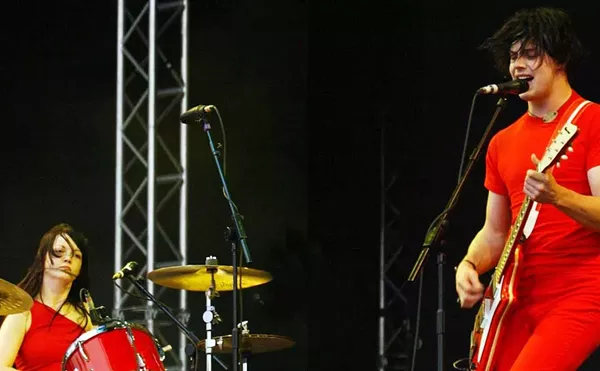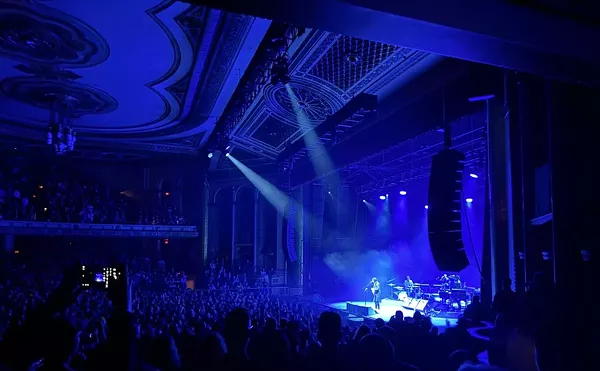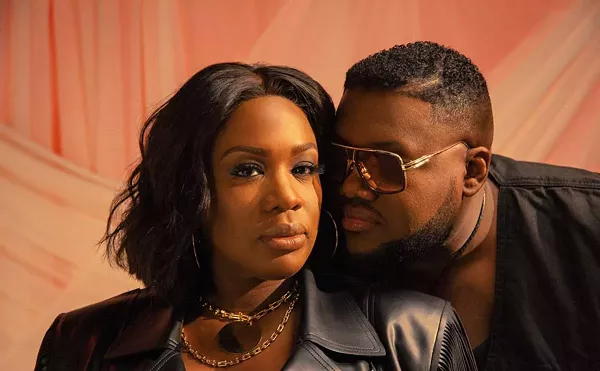
Audio By Carbonatix
[
{
"name": "GPT - Leaderboard - Inline - Content",
"component": "35519556",
"insertPoint": "5th",
"startingPoint": "3",
"requiredCountToDisplay": "3",
"maxInsertions": 100,
"adList": [
{
"adPreset": "LeaderboardInline"
}
]
}
]
Another clue that time, like the universe's matter, is accelerating: Music subcultures from only a decade ago now seem culled from ancient history. In the 1990s, albums of experimental music — cassette tape often being the low-cost, DIY format of choice — wound their way through an underground connected by post office boxes and zine ads. We're talking brick, mortar, paper. Web sites were just a blip; keeping in touch with the music required both persistence and luck. Crazy psych-folk, drone, noise — it was all happening, but who knew this stuff existed?
In 1994, one such tape featured the immersive, spacey ambience of storied locals Windy Weber and Carl Hultgren. It was called Portal, and it was the third release on their Blue Flea label. Issued in an edition of 200 copies, the artwork was handmade.
Up in East Lansing, a label called American Tapes — the brainchild of John Olson, of Dead Machines and international noise music standard-bearers Wolf Eyes — was documenting incredibly strange music by artists (often Olson and associates) like Universal Indians and Daylight Savings Time. Limited wasn't the word for these runs — 10 copies here, 25 there — and the packaging was even more rarefied. Maxells were encased in wood, wire and plaster; TDKs were shoved into decoratively painted Del Monte cans.
Meanwhile, back at the ranch — OK, Houston — a trio of folk primitives called Charalambides, led by Tom and Christina Carter, released a weird and wonderful cassette called Our Bed is Green on their own Wholly Other label in 1992.
Those were different times; but not everything is different. A decade and change later, three rivulets that carved out canyons in the '90s American underground will come together this week in Detroit in what promises to be a dizzying rush of sound.
It will be an interesting cross section of the vast independent experimental scene. While the stylistic overlap between the bands is minuscule, they share values as well as history. Each uses music to explore alternate states of being and probe new worlds. Within these spaces, tactile reality and the messiness of analog are prized over the computer's cold and unblinking efficiency. There's a here-and-now feeling to these bands, a hard physical presence in our increasingly virtual world. One senses a struggle to keep sonic art from drowning in the bitstream, and these guys seem to be winning. Rougher music from acoustic and analog sources has found its niche.
Windy Weber thinks some of these predilections might have to do with age. "There is a group of us, we were born and raised with albums and there is a very different sound quality to a record versus something that was made digitally," she says. "When we get together and talk music with Tom and Christina (Carter), we talk about tape delays, we talk about working with a reel-to-reel for recording. There's a completely different quality that you get out of this machinery."
Windy & Carl and the Charalambides go back. They've released music on the same record label — Chicago's Kranky — and have performed at the same festivals, including the now-legendary psych-folk gathering-of-the-tribes events Terrastock in the late 1990s.
This fondness for the handmade and analog could be a folk thing, even though none of these bands — save Charalambides, once in a while — fits the term in its typical sense.
Tovah Olson of Dead Machines, speaking from the home she shares with John in Ypsilanti, has some ideas that tie things together. A student of history and a collector, she thinks folk culture serves as a society's collective memory. "I feel like what we're doing with Dead Machines is in that tradition. We're documenting a culture and an era, a way of life," she says. "That's what a lot of folk music is: a snapshot of what's going on at the time."
For Dead Machines, the aesthetic extends to their instrumentation, affecting their sound directly. In comparison to the sharp-toothed aggression of Wolf Eyes, Dead Machines maintain a lower-level roar, the project's name offering some hints as to music's rusty, metallic groan. While John Olson generates sound with reeds, including bass clarinet and saxophone, Tovah has a fondness for more primitive hardware, including nearly dead gadgets that she keeps on life support. A key component of her current live setup, for example, is an old answering machine. She uses the outgoing message well as a tape loop device. She also deploys a mixer with a few built-in effects, and then a tin can affixed with a contact microphone. And that's it.
If these instruments sound like the contents of a box tucked in the back of a Goodwill that have yet to be sorted, there's a method at work that has to do with unpredictability, moving away from perfect replication and cherishing the here-and-then-gone moment.
"Using these things, I feel more connected to what I'm playing," Tovah says. "A lot of time the sounds that come out are so weird and surprising, they're almost out of your control."
Dead Machines, it seems, are dealing with a nature powered by electricity that can't be completely tamed. "With computers, you're never really surprised. But when you do the feedback thing, something interesting happens, and sometimes you can control it and sometimes you can't."
Tovah was born on Long Island and went to school at SUNY Purchase, where she met James Toth of the rising experimental folk outfit Wooden Wand, a band heavily influenced by Charalambides. She was a member of Wooden Wand in its formative stages, lending noises and feedback to the band's 2004 debut Angel Hair. Tovah says that her scattered contributions to the group have been way overplayed in the underground press; still, the Wooden Wand connection provides another intriguing intersection between acoustic folk and mechanical hum.
Of the three bands on this Detroit bill, Charalambides are the hardest to pin down. Their music includes exotic instrumentation and is defined by their willingness to let acoustic compositions bleed into free-form collages interspersed with Tom Carter's deeply psychedelic soloing topped by Christina piercing, wordless vocals. Their 2006 release on Kranky, A Vintage Burden, was their most muted and songwriterly effort to date. But for a band this rooted in improvisation, there's no telling what form their upcoming performance will take.
Windy and Carl's music has undergone a steady expansion since those days of vinyl singles and cassette albums. Their most recent release, the 2006 double CD The Dream House/Dedications to Flea, had pieces averaging a half-hour each. Their crystalline, slow-drift drones, which live will be produced with two guitars and pedals, sound like no one else working today, and are now completely untethered from rock.
CD-Rs have mostly replaced cassettes as the format of choice for low-cost, low-print-run records, and the network for experimental music has expanded a hundredfold. The Dead Machines CD-Rs on American Tapes label number in the dozens; Charalambides have almost as many on their Wholly Other label. We're still talking about objects. The packaging of these releases still matters, and the music — on disc and at the upcoming live show — is worn, flawed and human. The physical world — for now, anyway — still counts for something.
Charalambides, Windy & Carl and Dead Machines appear Friday, March 2, at the Magic Stick, 4120 Woodward Ave., Detroit; 313-833-9700. Showtime is 10:30 p.m.
Mark Richardson is a freelance writer. Send comments to letters@metrotimes.com




